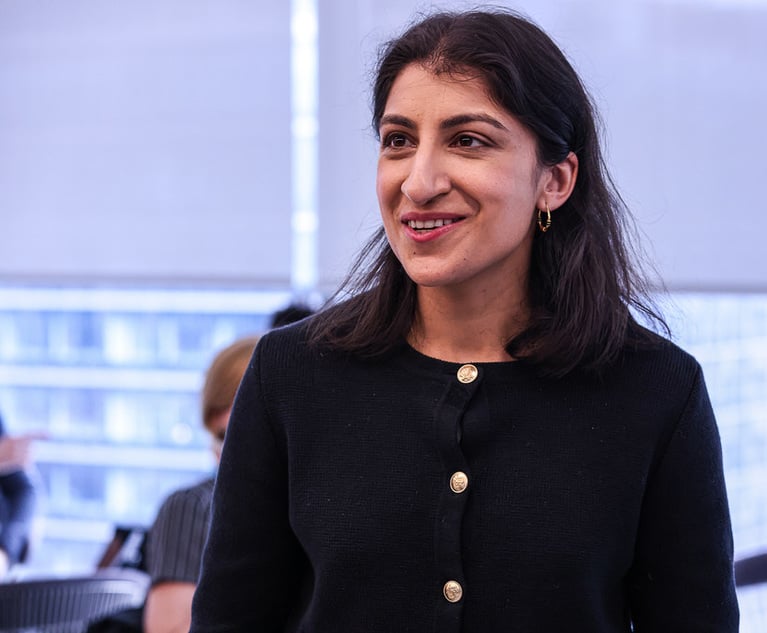Workplace Class Action Balloon Will 'Burst' as Trump Takeover Settles: Seyfarth Report
The rise in class action settlements and federal government workplace litigation last year is expected to soften as the Trump administration's takeover settles in, according to Seyfarth Shaw's annual workplace litigation report.
January 10, 2018 at 02:24 PM
4 minute read
 Seyfarth Shaw offices in Washington. Credit: Diego M. Radzinschi / NLJ
Seyfarth Shaw offices in Washington. Credit: Diego M. Radzinschi / NLJ
The rise in class action settlements and federal government workplace litigation last year may not have been what business leaders expected the first year of a Republican White House.
Seyfarth Shaw's annual report, Workplace Class Action Litigation Report, published on Wednesday, found the top class action settlements shot up by $1 billion year over year to reach an all-time record high—$2.72 billion.
Government enforcement in the transition year ballooned, according to the report. Many Obama-era cases and enforcement methods were a spillover from the Democratic administration, according to the report.
“There were counterintuitive results of government enforcement litigation at the federal level,” said Gerald Maatman Jr., a Seyfarth Shaw partner in the Chicago and New York offices and author of the report. “A lot of business folks thought with the new Republican White House, enforcement agencies would be business friendly. It took until the late fall in terms of changes in policies and outreach to the business community.”
Maatman predicted 2018 will be a year of a dramatic shift and agencies are not expected to be pursue with the same vigor the number of suits they did in previous years. He noted that Trump administration appointees and nominees for various agencies have signaled a change in direction.
The Seyfarth Shaw report showed the monetary value of the top workplace class action settlements rose by more than $970 million to reach a new high of $2.72 billion in 2017. The report notes the rise in employment discrimination actions, statutory workplace class actions and a jump in government enforcement cases. The largest increase was in government enforcement.
The report also found there were better statistical outcomes for employers opposing class certification requests for the second year in a row. In wage-and-hour litigation, for instance, employers won 63 percent of decertification rulings, which represented a 20 percent increase from 2016.
The enforcement litigation sparked from the federal government appeared to spill over from the Obama administration, the report said. Filings from the U.S. Equal Employment Opportunity Commission more than doubled—184 lawsuits compared to 86 the previous year. According to the EEOC, 124 of those suits were filed on behalf of individuals, 30 were non-systemic suits with more than one victims, and 30 were systemic suits.
The top government settlements also increased from $52.3 million in 2016 to $485 million last year.
Maatman said the Trump administration, as it settles and implements new approaches, would slow the rise in settlements. Still, he said he expects plaintiffs attorneys to step in.
Seyfarth Shaw's report also notes that employers are awaiting the outcome of a U.S. Supreme Court case that considers the legality of class action waivers in arbitration agreements. The court heard arguments in the case in October.
“The wild card is what is before the Supreme Court right now,” Maatman said. “[The case] will have such a major cause and effect on workplace litigation.”
Read more:
Microsoft, Fighting Class Action, Acknowledges Gender Imbalances in Tech Industry
Former Amazon Worker Seeks Class Certification in Overtime Suit
PricewaterhouseCoopers Can't Keep Secret Would-Be Class Size in Age Bias Suit
What Law Firms Said About Revising Obama's Overtime Rule
Wal-Mart's Top LGBT Ranking Came With an Asterisk—And What That Means
The US Justice Dept. Retreated From a Transgender Professor's Case. She Still Won.
This content has been archived. It is available through our partners, LexisNexis® and Bloomberg Law.
To view this content, please continue to their sites.
Not a Lexis Subscriber?
Subscribe Now
Not a Bloomberg Law Subscriber?
Subscribe Now
NOT FOR REPRINT
© 2025 ALM Global, LLC, All Rights Reserved. Request academic re-use from www.copyright.com. All other uses, submit a request to [email protected]. For more information visit Asset & Logo Licensing.
You Might Like
View All
'The Tobacco Industry of This Decade': Slew of Class Actions Accuse DraftKings of Creating Addicts
5 minute read
4th Circuit Revives Racial Harassment Lawsuit Against North Carolina School District
3 minute read
Khan Defends FTC Tenure, Does Not Address Post-Inauguration Plans

‘Old Home Week’: Justice Breyer Hears Challenge to Cruise Ship Ordinance in 1st Circuit
Trending Stories
Who Got The Work
Michael G. Bongiorno, Andrew Scott Dulberg and Elizabeth E. Driscoll from Wilmer Cutler Pickering Hale and Dorr have stepped in to represent Symbotic Inc., an A.I.-enabled technology platform that focuses on increasing supply chain efficiency, and other defendants in a pending shareholder derivative lawsuit. The case, filed Oct. 2 in Massachusetts District Court by the Brown Law Firm on behalf of Stephen Austen, accuses certain officers and directors of misleading investors in regard to Symbotic's potential for margin growth by failing to disclose that the company was not equipped to timely deploy its systems or manage expenses through project delays. The case, assigned to U.S. District Judge Nathaniel M. Gorton, is 1:24-cv-12522, Austen v. Cohen et al.
Who Got The Work
Edmund Polubinski and Marie Killmond of Davis Polk & Wardwell have entered appearances for data platform software development company MongoDB and other defendants in a pending shareholder derivative lawsuit. The action, filed Oct. 7 in New York Southern District Court by the Brown Law Firm, accuses the company's directors and/or officers of falsely expressing confidence in the company’s restructuring of its sales incentive plan and downplaying the severity of decreases in its upfront commitments. The case is 1:24-cv-07594, Roy v. Ittycheria et al.
Who Got The Work
Amy O. Bruchs and Kurt F. Ellison of Michael Best & Friedrich have entered appearances for Epic Systems Corp. in a pending employment discrimination lawsuit. The suit was filed Sept. 7 in Wisconsin Western District Court by Levine Eisberner LLC and Siri & Glimstad on behalf of a project manager who claims that he was wrongfully terminated after applying for a religious exemption to the defendant's COVID-19 vaccine mandate. The case, assigned to U.S. Magistrate Judge Anita Marie Boor, is 3:24-cv-00630, Secker, Nathan v. Epic Systems Corporation.
Who Got The Work
David X. Sullivan, Thomas J. Finn and Gregory A. Hall from McCarter & English have entered appearances for Sunrun Installation Services in a pending civil rights lawsuit. The complaint was filed Sept. 4 in Connecticut District Court by attorney Robert M. Berke on behalf of former employee George Edward Steins, who was arrested and charged with employing an unregistered home improvement salesperson. The complaint alleges that had Sunrun informed the Connecticut Department of Consumer Protection that the plaintiff's employment had ended in 2017 and that he no longer held Sunrun's home improvement contractor license, he would not have been hit with charges, which were dismissed in May 2024. The case, assigned to U.S. District Judge Jeffrey A. Meyer, is 3:24-cv-01423, Steins v. Sunrun, Inc. et al.
Who Got The Work
Greenberg Traurig shareholder Joshua L. Raskin has entered an appearance for boohoo.com UK Ltd. in a pending patent infringement lawsuit. The suit, filed Sept. 3 in Texas Eastern District Court by Rozier Hardt McDonough on behalf of Alto Dynamics, asserts five patents related to an online shopping platform. The case, assigned to U.S. District Judge Rodney Gilstrap, is 2:24-cv-00719, Alto Dynamics, LLC v. boohoo.com UK Limited.
Featured Firms
Law Offices of Gary Martin Hays & Associates, P.C.
(470) 294-1674
Law Offices of Mark E. Salomone
(857) 444-6468
Smith & Hassler
(713) 739-1250










